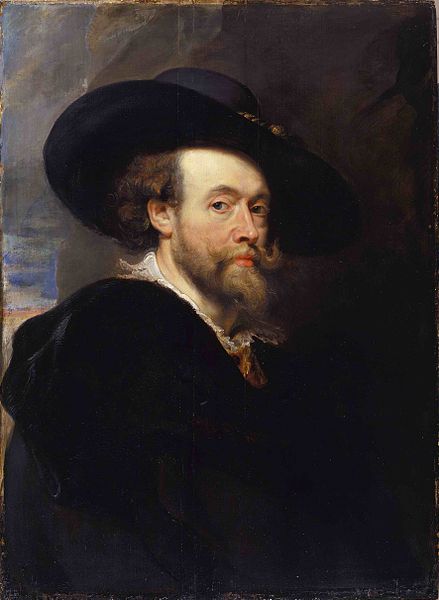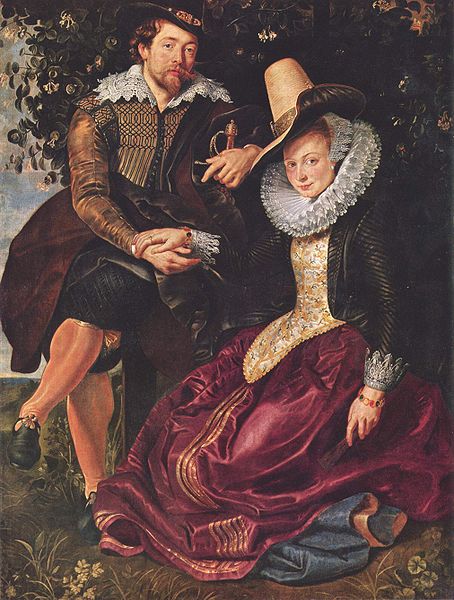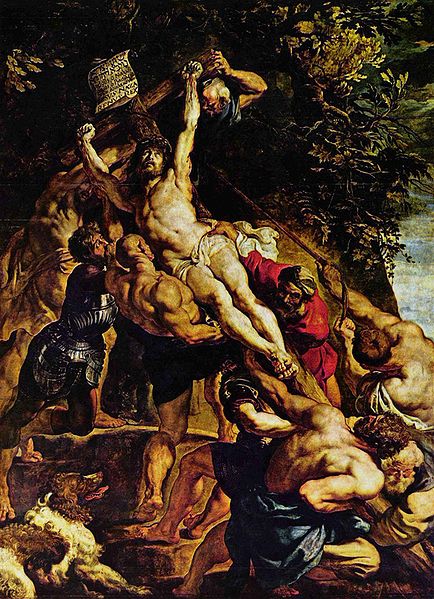| Peter Paul Rubens | |
|---|---|
 |
|
| Born | June 28, 1577 Siegen, Westphalia (modern-day Germany) |
| Died | May 30, 1640 (at age 62) |
| Nationality | Belgian |
| Movement | Baroque |
| Field | Painting, Diplomacy |
| Famous Paintings by Peter P. Rubens | |
| Samson and Delilah | |
| The Descent from the Cross | |
| Prometheus Bound | |
| The Raising of the Cross | |
| Adoration of the Magi | |
| Consequences of War | |
| Complete Works |
Sir Peter Paul Rubens was born on June 28, 1577 in Siegen, Westphalia. His parents were Calvinists, and were forced to leave their hometown Antwerp due to Religious persecution. When Peter was ten years old, his Dad was arrested for having an affair with the second wife of William of Orange. After the fiasco, they moved back to Antwerp, and converted to Catholicism. Peter enrolled n school, and studied Latin and classical literature. Since he showed a keen interest in art, he started an apprenticeship under Tobias Verhaeght by the age of 14.
By the age of 21, he was considered a Master for completing his studies, and in 1600, he traveled to Italy. Rubens loved all of Titian’s work, and was heavily influenced by him. He also loved Roman art, and did the Laocöon Drawing from the marble statue that was unearthed during the Renaissance. His picture depicts his awareness of the human body and the details are very realistic.
As he journeyed through Italy, he acquired patrons like the Duke of Mantua and Archduke Albert of Austria. The Archduke commissioned Ruben’s first altarpiece; a triptych of St. Helen with the True Cross finished in 1601. He then visited Spain in 1603 to look at the Titian art collection of Phillip II. He soon returned to Italy, and painted the altar at Santa Maria because Cardinal Jacopo Serra gave him the job. It depicts St. Gregory the Great.
 Being in Italy had a major impact on Rubens. Most of the letters he wrote were in Italian, and he signed his name Pietro Paulo Rubens. While in Italy, he received word that his mom was ill, and he went back to Antwerp. But when he got home, his mom was dead. Peter decided to stay there, and was appointed court painter to Albert and Isabella, governors of the Low Countries. On October 3, 1609, he married Isabella Brant, daughter of humanist Jan Brant. The next year, they moved into a house Rubens had designed, which looked like an Italian villa. It had a workshop, studio, and a personal library and art gallery.
Being in Italy had a major impact on Rubens. Most of the letters he wrote were in Italian, and he signed his name Pietro Paulo Rubens. While in Italy, he received word that his mom was ill, and he went back to Antwerp. But when he got home, his mom was dead. Peter decided to stay there, and was appointed court painter to Albert and Isabella, governors of the Low Countries. On October 3, 1609, he married Isabella Brant, daughter of humanist Jan Brant. The next year, they moved into a house Rubens had designed, which looked like an Italian villa. It had a workshop, studio, and a personal library and art gallery.
In 1610, he painted Raising of the Cross, which is one of his most famous triptych paintings. It has Italian influence, especially the way the body is portrayed. But, it has its Baroque aspects to it, like the use of chiaroscuro, with Jesus being surrounded by light and the outside being obscured by shadows. The overall theatricality of the piece makes it Baroque. This piece was meant for the Cathedral of Our Lady.
 His next big commission was in 1621 by Marie de Medici, the Queen Mother of France. She wanted Peter to paint two series, the Marie de’ Medici Cycle, and another Cycle for her late husband Henry IV, which would portray their lives in a series of portraits. Marie’s was finished in 1625, but Henry’s was never completed, for she were thrown from power by her son, Louis XIII in 1630. Marie moved to the Netherlands after being removed from the throne. Around this time, Rubens started to be a diplomat for the Spanish Hapsburg rulers. His goal was to bring peace between the Spanish Netherlands and the United Provinces which were owned by England.
His next big commission was in 1621 by Marie de Medici, the Queen Mother of France. She wanted Peter to paint two series, the Marie de’ Medici Cycle, and another Cycle for her late husband Henry IV, which would portray their lives in a series of portraits. Marie’s was finished in 1625, but Henry’s was never completed, for she were thrown from power by her son, Louis XIII in 1630. Marie moved to the Netherlands after being removed from the throne. Around this time, Rubens started to be a diplomat for the Spanish Hapsburg rulers. His goal was to bring peace between the Spanish Netherlands and the United Provinces which were owned by England.
During his life, Peter received many gifts for being an artist. He was knighted twice, once by Phillip IV of Spain, 1624, and Charles I of England, 1630. He was awarded Master of Arts degree by Cambridge University in 1629. He was also very well connected with all the royals in all the countries through his diplomatic missions.
Regrettably, Isabella died in 1626, and he was devastated. He remarried in 1630, to a 16 year old girl named Hélène Fourment. He was 53. Later on that year, he painted Allegory of Peace and War, which he gave to Charles I as a present for knighting him. In 1635, he bought le Château du Steen, which was located in France and it was a peaceful place to live. The house is featured in a few paintings, like le Château du Steen; the Farmer.
Hélène inspired him in all his future paintings, for she was a voluptuous woman, and the curvy figure was popular then. For instance, The Judgment of Paris, painted in 1638, all three girls are sensuous in their poses, trying to entice Paris to choose them. Another picture painted that year, The Garden of Love, has Hélène in the painting, and Peter beside her.
Peter Paul Rubens died of gout on May 30, 1640. Gout, also known as Richman’s Disease, gives the sufferer severe arthritis, and makes your urine thick. The cause of the disease is an increase of uric acid in the blood. He is interred at the St. Jacopo’s Church in Antwerp. He left behind eight kids, three he had with Isabella and five he had with Hélène. The youngest was born eight months after he died.